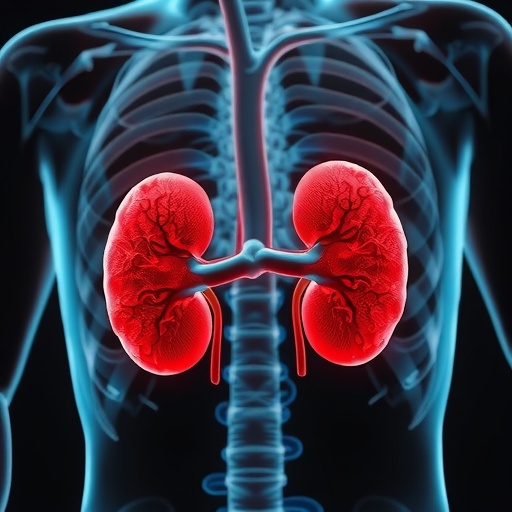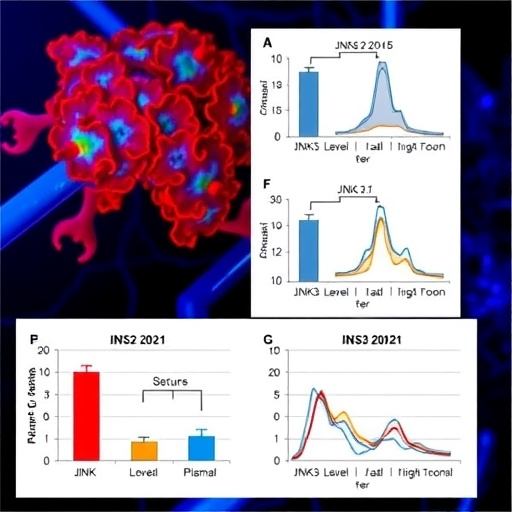A recent study has shed light on the potential benefits of tiron, a chemical compound, in protecting against the nephrotoxic effects of diclofenac, a widely used non-steroidal anti-inflammatory drug (NSAID). As the world continues to confront the risk of drug-induced kidney injury, this research highlights an important therapeutic avenue by targeting the complex molecular pathways involved. The study is crafted by a group of esteemed researchers, including Ragab, El-Kelany, and Sewilam, who explore the intricate interaction between oxidative stress, inflammatory responses, and renal health.
Diclofenac is commonly prescribed for its analgesic and anti-inflammatory properties. However, clinical and experimental evidence has increasingly illuminated its adverse effects, especially regarding kidney function. Reports have established a link between diclofenac use and kidney toxicity, raising alarm bells among healthcare providers and patients alike. Patients with pre-existing conditions, like chronic kidney disease, are particularly vulnerable. This necessitates a closer examination of the molecular mechanisms that mediate diclofenac’s nephrotoxic effects.
The research delves deep into the signaling pathways implicated in this renal toxicity, with a focus on TLR4/NF-κB/NLRP3/Caspase-1/IL1-β. This intricate cascade of molecular events underscores the importance of inflammation and oxidative stress in the context of nephrotoxicity. TLR4, or Toll-like receptor 4, plays a crucial role in the immune response and has been identified as a key player in mediating inflammatory responses to stressors like drugs. The activation of TLR4 leads to the recruitment of various downstream signaling proteins, ultimately activating the nuclear factor kappa-light-chain-enhancer of activated B cells (NF-κB).
Upon activation, NF-κB propagates inflammatory responses by inducing the expression of pro-inflammatory cytokines. Among these, IL-1β is particularly noteworthy due to its capacity to exacerbate inflammation and promote further cellular damage. Meanwhile, the NLRP3 inflammasome, a multi-protein complex, serves as a sensor for cellular stress and danger signals, leading to the activation of caspase-1, which in turn promotes the maturation and secretion of IL-1β. The interplay among these molecules illustrates how mitochondrial dysfunction and oxidative stress converge to drive renal injury during NSAID treatment.
In the face of these challenging pathways, tiron emerges as a promising candidate for mitigating the nephrotoxic effects induced by diclofenac. Researchers have identified tiron’s potent antioxidant properties as a crucial mechanism through which it exerts its protective effects. By scavenging reactive oxygen species (ROS) and reducing oxidative stress, tiron may effectively diminish the harmful impacts of diclofenac on kidney tissue.
The experimental design of the study involved exposing renal cells to diclofenac and subsequently treating them with tiron. The results demonstrated a significant reduction in markers of oxidative stress and inflammation in the presence of tiron. This finding not only supports the hypothesis that oxidative stress plays a central role in diclofenac-induced nephrotoxicity but also suggests that tiron may provide a protective barrier against such effects.
Additionally, the study employed a range of molecular and biochemical assays to quantify the impact of tiron on the activation of key signaling pathways. This comprehensive analysis confirmed that tiron administration resulted in decreased activation of TLR4, NF-κB, and the NLRP3 inflammasome, leading to reduced secretion of inflammatory cytokines like IL-1β. These findings collectively paint a compelling picture of tiron’s renoprotective potential.
Amidst the scientific community, excitement is building around the implications of this research. If tiron’s protective properties can be validated further through clinical trials, it may transform the therapeutic landscape for patients at risk of NSAID-related kidney damage. The potential of this compound could extend beyond diclofenac, offering insight into protective strategies for other medications that carry similar nephrotoxic risks.
As with any groundbreaking research, it is essential to approach these findings with a critical eye. The study presents a strong foundation upon which future investigations can build. Understanding the full scope of tiron’s effects on renal function, its pharmacokinetics, and potential side effects in human populations remains a crucial next step.
Furthermore, this research contributes to a broader conversation about the need for safer analgesic and anti-inflammatory medications. As the population ages and the prevalence of chronic pain conditions increases, the demand for effective yet safe therapeutic options continues to grow. Innovations like tiron could play a pivotal role in addressing this unmet need.
Moreover, this study serves as a reminder of the intricate connections between inflammation, oxidative stress, and kidney health. It emphasizes the need for ongoing research into the myriad factors influencing kidney function and the development of nephrotoxicity. The quest for new therapeutic agents must remain a priority as we navigate the complexities of pharmacotherapy.
Ultimately, as researchers continue to unravel the complexities of drug-induced toxicity, the insights from this study usher in a new era of targeted renal protection. The renoprotective impact of tiron may represent a step forward in safeguarding public health against the backdrop of pharmaceutical treatment, marking an important chapter in the ongoing dialogue on drug safety. The potential for tiron to reshape how clinicians manage NSAID therapy could lead to better outcomes for patients, who are often left to navigate the dangerous waters of pain management without adequate safety nets.
As the scientific community processes these findings, the hopes are high for tiron and its role in nephroprotection. Whether this compound can transition from bench to bedside remains to be seen, but the trajectory is promising. The emerging evidence provides a beacon of hope for those seeking safer alternatives for managing pain while minimizing the risk of renal injury.
The dialogue surrounding drug safety is more critical now than ever, and research such as this study is foundational in shaping future directions in pharmacology and toxicology. The commitment to finding solutions must continue, driven by the pursuit of improved health outcomes and the overarching goal of safeguarding patient wellbeing.
The relevance of these findings extends beyond immediate therapeutic implications; they also elevate the understanding of renal physiology in the context of drug metabolism and toxicity. As the world grapples with the consequences of medication overuse and associated health crises, studies that illuminate pathways toward safer drug alternatives will undoubtedly shape the landscape of modern medicine.
Subject of Research: Renoprotective effects of tiron against diclofenac-induced nephrotoxicity.
Article Title: Renoprotective impact of tiron against diclofenac-induced nephrotoxicity: targeting TLR4/NF-κB/NLRP3/Caspase-1/IL1-β pathway.
Article References: Ragab, A.S., El-Kelany, A.S., Sewilam, H.M. et al. Renoprotective impact of tiron against diclofenac-induced nephrotoxicity: targeting TLR4/NF-κB/NLRP3/Caspase-1/IL1-β pathway. BMC Pharmacol Toxicol 26, 179 (2025). https://doi.org/10.1186/s40360-025-01012-z
Image Credits: AI Generated
DOI:
Keywords: Tiron, nephrotoxicity, diclofenac, renal protection, TLR4, NF-κB, NLRP3, Caspase-1, IL-1β, oxidative stress, inflammation.
Tags: Caspase-1 and IL1-β in kidney damagechronic kidney disease risk factorsdiclofenac kidney toxicitydrug-induced kidney injury researchinflammatory responses in nephrotoxicitymolecular mechanisms of nephrotoxicitynon-steroidal anti-inflammatory drugsoxidative stress and kidney healthprotective compounds against NSAID toxicityrenal health therapeutic strategiesTiron nephroprotectionTLR4 signaling pathways





